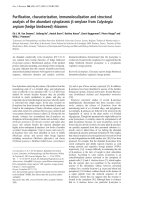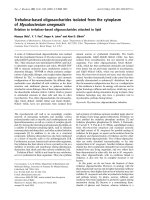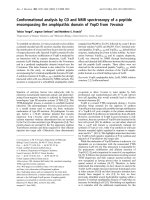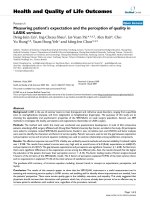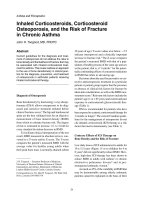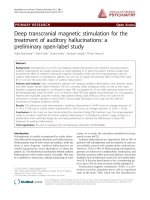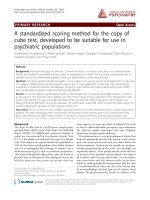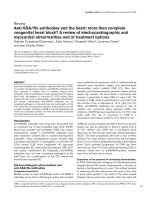Báo cáo y học: "Inhaled Corticosteroids, Corticosteroid Osteoporosis, and the Risk of Fracture in Chronic Asthma" pps
Bạn đang xem bản rút gọn của tài liệu. Xem và tải ngay bản đầy đủ của tài liệu tại đây (213.15 KB, 6 trang )
28
Abstract
Current guidelines for the diagnosis and treat-
ment of osteoporosis do not address the risks to
bone density and the likelihood of fracture that may
be associated with inhaled corticosteroid treat-
ment for asthma. This review outlines an approach
to the use of bone densitometry in clinical prac-
tice for the diagnosis, prevention, and treatment
of osteoporosis in asthmatic patients receiving
inhaled corticosteroid therapy.
Diagnosis of Osteoporosis
Bone densitometry by dual-energy x-ray absorp-
tiometry (DXA) allows osteoporosis to be diag-
nosed and corrective treatment initiated before
clinical fractures occur.
1
The hip and lumbosacral
spine are the best validated sites for an objective
measurement of bone mineral density (BMD)
from which to estimate fracture risk. The degree
of risk is estimated to increase 1.5- to 3-fold for
every standard deviation decrease in BMD.
To facilitate clinical interpretation of the test
result, BMD measured in absolute terms is con-
verted to a T-score and/or Z-score. The T-score
compares the patient’s measured BMD with the
average value for healthy young adults when
their peak bone mass is normally attained (about
30 years of age). T-score values at or below Ϫ2.5
indicate osteoporosis and a clinically important
increase in fracture risk.
2
The Z-score compares
the patient’s measured BMD with that of a pop-
ulation of healthy persons of the same age and sex
as the patient, that is, it “controls” for the poten-
tially confounding effects of concurrent reductions
in BMD that relate to advancing age.
Decisions about the need for preventive or cor-
rective antiosteoporosis treatment in a particular
patient or patient group require that the presence
or absence of clinical risk factors for fracture be
taken into consideration, as well as the BMD mea-
surement score.
3
Relevant risk factors include the
patient’s age (> or < 65 years) and current and past
exposure to corticosteroid (glucocorticoid) ther-
apy (Table 1).
DXA is recommended for patients who have
been exposed to systemic corticosteroid therapy for
3 months or longer.
3
The current Canadian guide-
lines for the management of osteoporosis do not
cite inhaled corticosteroid (ICS) therapy as a risk
factor that merits densitometry (see Table 1).
Contrary Effects of ICS Therapy on
Bone Density and the Risk of Fracture
Low daily doses of ICS administered to adults for
10 ± 5.5 years (Figure 1)
4
or to children for 4 to
6 years
5
did not significantly reduce BMD. How-
ever, high-dose ICS therapy has been shown to
reduce BMD in adults with asthma
4
or chronic
obstructive pulmonary disease
6
and in pre-
menopausal asthmatic women.
7
As much as 45% of the variability in BMD that
may be demonstrable among elderly asthmatic
patients cannot be explained on the basis of their
Asthma and Therapeutics
Inhaled Corticosteroids, Corticosteroid
Osteoporosis, and the Risk of Fracture
in Chronic Asthma
John H. Toogood, MD, FRCPC
J. H. Toogood — Emeritus Professor of Medicine,
University of Western Ontario, Division of Clinical
Immunology and Allergy, Department of Medicine,
London Health Sciences Centre, London, Ontario
Correspondence to: Dr. John H. Toogood, 194 Hunt Club
Drive, London, ON N6H 3Y9
Inhaled Corticosteroids, Corticosteroid Osteoporosis, and Fracture in Asthma — Toogood 29
past or current exposures to corticosteroid therapy
or other clinically identifiable risk factors for osteo-
porosis.
4,8
Genetic determinants, as yet not
identified, are thought to account for much of this
variability. Some identifiable factors that may act
to conserve or restore BMD in asthmatic adults
receiving long-term ICS therapy, and thereby
reduce their risk of fracture, are shown in Table 2.
A cross-sectional survey by DXA in asth-
matic adults previously treated with prednisone
found that higher current daily doses of ICS were
associated with reduced Z-score values for BMD
(see Figure 1), whereas in the same patient group,
larger cumulative lifetime exposures to ICS cor-
related paradoxically with higher BMD values (see
Table 2) and a corollary, clinically important,
dose-related reduction in the numbers of patients
at risk of fracture (Table 3).
4
This illustrates the
fact that despite prolonged and continuing expo-
sure to prednisone, osteoporosis remains a poten-
tially reversible process, and substituting ICS for
current prednisone use may, in many patients,
conserve or improve BMD sufficiently to reduce
the risk of fracture to a level approximating that
of healthy persons of the same age and sex who
have never been exposed to inhaled or oral cor-
ticosteroid therapy (see Table 3). Prednisone with-
drawal and increased physical activity conse-
quent to improved asthma control may be
proximate causes of this favourable outcome of
ICS treatment (see Table 2).
Prevention and Treatment of
Glucocorticoid-Induced Osteoporosis
It is recommended that the presence or absence of
clinical risk factors for osteoporosis and fracture
Table 1 Factors That Identify People Who Should Be Assessed for Osteoporosis
Major Risk Factors Minor Risk Factors
Age > 65 yr Rheumatoid arthritis
Vertebral compression fracture Past history of clinical hyperthyroidism
Fragility fracture after age 40 yr Chronic anticonvulsant therapy
Family history of osteoporotic fracture Low dietary calcium intake
(especially maternal hip fracture) Smoker
Systemic glucocorticoid therapy Excessive alcohol intake
of > 3 mo duration Excessive caffeine intake
Malabsorption syndrome Weight < 57 kg
Primary hyperparathyroidism Weight loss > 10% of weight at age 25 yr
Propensity to fall Chronic heparin therapy
Osteopenia apparent on radiograph
Hypogonadism
Early menopause (before age 45 yr)
Adapted from Brown JP et al.
3
Figure 1 Regression of lumbosacral bone mineral den-
sity on the daily dose of inhaled corticosteroid in a cross-
sectional analysis of bone density in 69 corticosteroid-
dependent adults with moderate to severe chronic
asthma.
4
The calculated mean regression (± 95% con-
fidence limits) is adjusted to control for the effects of
age, sex, years of estrogen use, physical activity, the cur-
rent daily dose of prednisone, years of prednisone use,
and the cumulative lifetime dose of inhaled corticos-
teroid. Bone density declined significantly on the cur-
rent daily dose of inhaled corticosteroid (p = .013
analysis of covariance). At doses ≤ 1.0 mg/d, bone
density did not differ significantly from normal. SEM
= standard error the mean.
-0.0
NormalOsteopeniaOsteoporosis
-0.5
-1.0
-1.5
-2.5
-2.0
-3.5
-4.0
0.0 0.5 1.0 1.5 2.0 2.5 3.0 3.5 4.0
-3.0
Lumbaosacral Bone Density Z-Score
(Adjusted mean +/- 2 SEM)
Current Dose of Inhaled Corticosteroid (mg/d)
30 Allergy, Asthma, and Clinical Immunology / Volume 1, Number 1, October 2004
be documented and a baseline DXAmeasurement
secured in patients who are commencing ICS ther-
apy and appear likely to need a maintenance dose
> 1.0 mg beclomethasone dipropionate (BDP) per
day or a systemically equivalent dose of an alter-
native ICS.
9
Depending on the DXAresult and clin-
ical considerations, appropriate antiosteoporosis
therapy may be indicated.
Current guidelines recommend that all patients
receiving glucocorticoid therapy take an oral cal-
cium supplement daily (at least 1,000 mg of Ca
++
)
plus activated vitamin D
2
.
3
For patients who use
medium to high doses of glucocorticoid, activated
vitamin D
3
(cholecalciferol) is preferred over vit-
amin D
2
because the latter is less potent.
In asthma patients deemed to be potentially
at risk despite normal BMD, an orally adminis-
tered bisphosphonate antiresorptive agent
(etidronate, alendronate, risedronate) may be
indicated to prevent bone loss.
2,3,10,11
In patients
who are already at risk because of established
glucocorticoid-induced osteoporosis, bisphos-
phonates have the capacity to restore bone mass
and thus reduce the risk of vertebral fracture.
3
They are currently recommended as first-line
therapy for the prevention or treatment of osteo-
porosis in men or postmenopausal women who
use prednisone at doses ≥ 5 mg/d.
3
However, bis-
phosphonates are generally not appropriate for
young women or children.
12
Bisphosphonates
and calcium should not be taken at the same
time of day because the calcium impairs absorp-
tion of the bisphosphonate.
Therapeutic Tactics
It is important that the daily dose of ICS be
adjusted individually for each patient to ensure that
it is adequate to fully control day-to-day asthma
symptoms, to eliminate the need for long-term
prednisone, and to prevent exacerbations of
asthma that trigger periodic intervention with
high and potentially bone-depleting doses of pred-
nisone. The bone-depleting effect of episodic
high-dose prednisone use has been shown to per-
sist long after the transient high-dose regimen
has been terminated.
13
The daily dose of ICS should be sufficient to
facilitate daily weight-bearing (impact type) phys-
ical activity.
14
A regular exercise regimen suited
to the particular needs and capacity of each patient
should be encouraged.
3
With a high-potency antiasthmatic ICS such
as fluticasone, most patients achieve an optimal
therapeutic response with a dose ≤ 0.5 mg/d.
15,16
Higher doses increase the risk of adverse sys-
temic effects disproportionately.
15
For patients who need a high daily dose of ICS
to ensure optimum control of unstable asthma,
the current treatment of choice is a combination
formulation such as fluticasone plus salmeterol
17
or budesonide plus formoterol.
18
Administered
twice daily, these products offer the advantage
that equivalent asthma control may be achieved
with a lower and safer daily dose of ICS.
17,18
Alternatively, in patients with unstable mod-
erate to severe chronic asthma, administering
Table 2 Correlates of Higher Lumbosacral Bone Density Z-Score Values
in ICS-Treated Asthmatic Adults*
Correlates of Higher Bone Density p Value (ANCOVA)
Larger cumulative lifetime dose of ICS .002
Lower current daily dose of ICS .013
Fewer years of prednisone exposure .032
Greater physical activity .042
More years of supplemental estrogen use .058
Adapted from Toogood JH et al.
4
ANCOVA= analysis of covariance; ICS = inhaled corticosteroid.
*N = 69. Age: 59.9 ± 13.3 yr (SD).
Years of steroid exposure (mean ± SD): prednisone = 10.7 ± 9.7 yr, ICS = 10.1 ± 5.5 yr.
approved doses of a standard formulation of
budesonide (without the adrenergic component)
in four rather than two divided treatments each day
can increase the antiasthmatic potency of the ICS
as much as six to sevenfold (Figure 2)
19
and mate-
rially improve clinical outcomes
20
without an
accompanying increase in systemic risks or
cost.
19,20
For many patients, cost is likely to be a
major determinant of whether ICS is prescribed
or dispensed.
21
For patients with mild persistent asthma, the
combination of salmeterol plus fluticasone is more
effective than the antileukotriene montelukast.
17
On
the other hand, in patients with more severe asthma
suboptimally controlled on low or moderate doses
of ICS, high-dose zafirlukast may provide an
effective nonsteroidal alternative to increasing
the corticosteroid dose.
22
For postmenopausal asthmatic women, an
estrogen and progesterone supplement is recom-
mended to reduce the risk of fracture.
3
To maxi-
mize its bone-conserving effect, the estrogen
replacement should commence soon after the
advent of menopause.
Bisphosphonate therapy currently constitutes
a first-line choice for the treatment or prevention
of glucocorticoid-induced osteoporosis.
3
Caution
is advised with respect to its use in premenopausal
women.
23
Applications of DXA in Clinical Practice
Bone densitometry is deemed appropriate where
the results of the test may reasonably be expected
to directly influence patient management.
1
Patients with at least one major or two minor
risk factors for fracture are candidates for DXA(see
Table 1). Systemic glucocorticoid therapy for more
than 3 months is identified as a major risk factor.
1,3
DXAis also recommended for asthmatic adults who
require an ICS dose with a systemic potency equal
to or exceeding that of 1.0 mg BDP per day.
9
However, regardless of the daily dose, DXA
should be sought routinely in elderly asthmatic
patients receiving ICS or prednisone treatment
because a majority may exhibit a clinically impor-
tant (and potentially treatable) increase in fracture
risk. Furthermore, the degree of risk or nonrisk
in a particular patient cannot be accurately esti-
mated from any combination of the identifiable
risk factors for osteoporosis and/or common clin-
ical features of hypercortisonism and/or records
of their current or past inhaled and/or oral corti-
costeroid exposure, with or without accompany-
ing measurement of laboratory indices of bone
metabolism.
8
Contradictory findings have been reported
as to the accumulative effects of prolonged ICS
treatment on BMD.
4–7,24,25
It has been suggested
Inhaled Corticosteroids, Corticosteroid Osteoporosis, and Fracture in Asthma — Toogood 31
Table 3 Cumulative Dose-Related Reduction in Fracture Risk Achieved by Steroid-Dependent
Asthmatic Adults after Substituting ICS for Past Prednisone Therapy
Percent of Group with Normal Bone Density*
Cumulative Lifetime ICS Exposure Men (n = 26) Women (n = 43)
†
(10.1 ± 5.5 yr) Age 58.5 ± 17.6 (SD) yr Age 60.8 ± 9.6 (SD) yr
≤3 g
‡
20 50
> 3 g
‡
40
§
65
§
Adapted from Toogood JH et al.
4
ICS = inhaled corticosteroid.
*Lumbosacral bone mineral density Z-score (LBMD-Z): +4 to Ϫ1.
†
All postmenopausal women received supplemental estrogen.
‡
Median lifetime cumulative ICS exposure = 3 g. Lifetime prednisone exposures were balanced equally between the higher
and lower lifetime ICS exposure subgroups (p = .87).
4
§
Larger lifetime exposures to ICS were associated with more normal LBMD-Z scores (p = .002 analysis of covariance) and a
substantially larger number of patients with Z-scores indicating no increase in fracture risk.
4
32 Allergy, Asthma, and Clinical Immunology / Volume 1, Number 1, October 2004
that patients with a cumulative lifetime exposure
to ICS that exceeds 5.0 g should be candidates for
DXAand, depending on the result, considered for
preventive intervention to reduce their risk of
fracture in later life.
25
The preliminary measure-
ment by DXAis important because some patients
retain normal BMD values despite prolonged
exposure to ICS therapy (see Figure 1 and Table
3). Therefore, they have no appreciable clinical
need for active intervention with antiresorptive
therapy.
A T-score value at or below Ϫ2.5 as deter-
mined by DXA indicates established osteoporo-
sis and an important increase in fracture risk.
2
T-
scores in the osteopenic range between Ϫ1 and
Ϫ2.5 indicate a need for antiresorptive treatment
to prevent further bone depletion.
2
Where the diagnosis of osteopenia or osteo-
porosis has been confirmed by DXA and
corrective bisphosphonate therapy initiated, the
response to the bisphosphonate should be moni-
tored by serial DXAexaminations at intervals of
about 1 to 3 years.
3
It is not yet known whether the early intro-
duction of long-term low-dose ICS therapy in
young children with mild asthma may ultimately
reduce the peak bone mass that they attain at
maturity. A baseline DXA measurement may be
appropriate in such patients when they attain 30
years of age—with appropriate follow-up depend-
ing on the result.
Acknowledgments
Special thanks to Maria Bettencourt for assis-
tance in manuscript preparation and Peter B. Too-
good, BSc (Eng), BSc (Pharm) for assistance in
the literature review.
References
1. Khan AA, Brown JP, Kendler DL, et al. The
2002 Canadian bone densitometry recommen-
dations: take home messsages. Can Med
Assoc J 2002;167:1141–5.
2. Assessment of fracture risk and its application
to screening for post-menopausal osteoporosis.
Geneva: World Health Organization; 1994.
WHO Technical Report Series No.: 843.
3. Brown JP, Josse RG, for the Scientific
Advisory Council of the Osteoporosis Society
of Canada. The 2002 clinical practice guide-
lines for the diagnosis and management of
osteoporosis in Canada. Can Med Assoc J
2002;167 Suppl):S1–34.
4. Toogood JH, Baskerville JC, Markov AE, et
al. Bone mineral density and the risk of frac-
ture in patients receiving long-term inhaled
steroid therapy for asthma. J Allergy Clin
Immunol 1995;96:157–66.
5. Childhood Asthma Management Program
Research Group. Long term effects of budes-
onide or nedocromil on children with asthma.
N Engl J Med 2000;343:1054–63.
6. Lung Health Study Group. Effect of inhaled
triamcinolone on the decline in pulmonary
function in chronic obstructive pulmonary dis-
ease. N Engl J Med 2000;343:1902–9.
Figure 2 Comparison of the effects of two different
dosing frequencies on the antiasthmatic (left panel) and
systemic (right panel) responses to three graded per
diem doses of budesonide (BUD) administered to 34
adults with moderate to severe unstable chronic
asthma.
19
The systemic effect of BUD was measured
in terms of its impact on the 8:00 am serum cortisol
level. Every patient took each of the six dose ϫ dos-
ing frequency combinations for the same length of
time in a prospective, double-blind, balanced crossover
protocol. To achieve an antiasthmatic response equiv-
alent to that obtained with four BUD treatments per
day, twice-daily treatment required a six- to sevenfold
higher daily dose of BUD (arrows in left panel). This
entailed a commensurate increase in the systemic tox-
icity of the inhaled corticosteroid (compare arrow
symbols in the right panel). ANOVA = analysis of
variance; PEFR = peak expiratory flow rate.
40
P from ANOVA
DOSE <.005
Frequency .94
P from ANOVA
DOSE .001
Frequency .002
Change in PEFR (L/min)
Change in Serum Cortisol (mcg/dL)
30
20
10
0
-10
0.2 0.4 0.8 1.6 0.2 0.4 0.8 1.6
10
5
0
-5
-10
-15
QID BID
BIDQID
Log Dose BUD (mg/d)
Log Dose BUD (mg/d)
Inhaled Corticosteroids, Corticosteroid Osteoporosis, and Fracture in Asthma — Toogood 33
7. Israel E, Bannerjee TR, Fitzmaurice GM, et al.
Effects of inhaled glucocorticoids on bone
density in pre-menopausal women. N Engl J
Med 2001;345:941–7.
8. Toogood JH, Hodsman AB, Fraher LJ, et al.
Serum osteocalcin and procollagen as markers
for the risk of osteoporotic fracture in corti-
costeroid-treated asthmatic adults. J Allergy
Clin Immunol 1999;104:769–74.
9. Boulet L-P, Becker A, Bérubé D, et al.
Canadian asthma consensus report, 1999. Can
Med Assoc J 1999;161 Suppl:S1–61.
10. Lau EMC, Woo J, Chan YH, Li M.
Alendronate for the prevention of bone loss in
patients on inhaled steroid therapy. Bone
2001;29:506–10.
11. Adachi JD, Bensen WG, Brown J, et al.
Intermittent etidronate therapy to prevent cor-
ticosteroid-induced osteoporosis. N Engl J
Med 1997;337:382–7.
12. Dawson-Hughes B. Bone loss accompanying
medical therapies. N Engl J Med
2001;345:989–91.
13. Dubois EF, Roder E, Deakhuijzen E, et al.
Dual energy x-ray absorptiometry outcomes in
male COPD patients after treatment with dif-
ferent glucocorticoid regimens. Chest
2002;12:1456–63.
14. Dalsky GP, Stocke KS, Ehsani AA, et al.
Weight bearing exercise training and lumbar
bone mineral content in post-menopausal
women. Ann Intern Med 1998;108:824–8.
15. Holt S, Suder A, Weatherall M, et al.
Dose-response relation of inhaled fluticasone
propionate in adolescents and adults with
asthma: meta-analysis. BMJ 2001;
323:253–6.
16. Nelson HS, Busse WW, deBoisblanc BP, et al.
Fluticasone propionate powder: oral corticos-
teroid-sparing effect and improved lung func-
tion and quality of life in patients with severe
chronic asthma. J Allergy Clin Immunol
1999;103:267–75.
17. Nelson HS. Combination treatment with fluti-
casone/salmeterol in the treatment of asthma. J
Allergy Clin Immunol 2001;107:397–416.
18. Pauwels RA, Lofdahl CG, Postma DS, et al.
Effect of inhaled formoterol and budesonide
on exacerbations of asthma. N Engl J Med
1997;337:1405–10.
19. Toogood JH, Baskerville JC, Jennings BJ, et
al. Influence of dosing frequency and schedule
on the response of chronic asthmatics to the
aerosol steroid, budesonide. J Allergy Clin
Immunol 1982;70:288–98.
20. Malo J-L, Cartier A, Merland N, et al. Four
times a day dosing frequency is better than a
twice-a-day regimen in subjects requiring a
high dose inhaled steroid, budesonide, to con-
trol moderate to severe asthma. Am Rev
Respir Dis 1989;140:625–8.
21. Kozyskj AL, Mustard CA, Cheang MS, et al.
Income-based drug-benefit policy: impact on
receipt of inhaled corticosteroid prescriptions
by Manitoba children with asthma. Can Med
Assoc J 2001;165:897–902.
22. Virchow JC Jr, Prasse A, Naya I, et al.
Zafirlukast improves asthma control in
patients receiving high dose inhaled cortico-
steroids. Am J Respir Crit Care Med
2000;162:578–85.
23. Recommendations for the prevention and
treatment of glucocorticoid-induced osteo-
porosis, 2001 update. Arthritis Rheum
2001;44:1496–503.
24. Wong CA, Walsh LJ, Smith CJP, et al.
Inhaled corticosteroid use and bone mineral
density in patients with asthma. Lancet
2000;355:1399–403.
25. Sambrook PN. Inhaled corticosteroids, bone
density, and the risk of fracture. Lancet
2000;355:1385.
